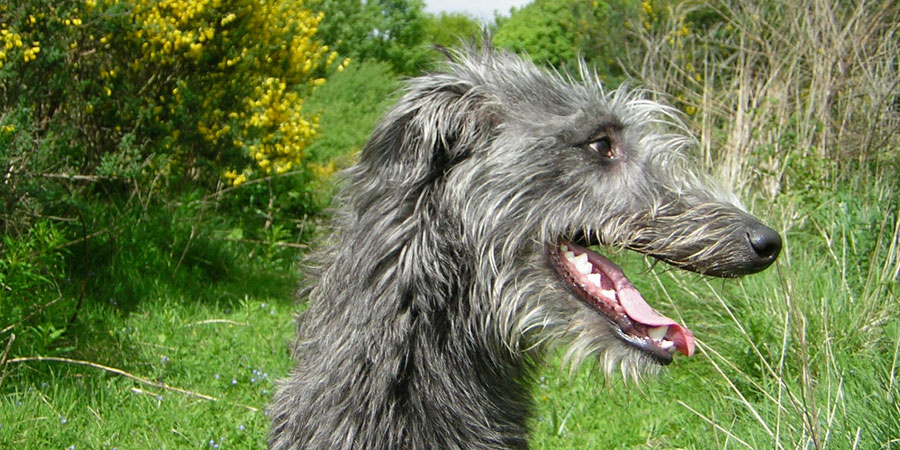

Deerhound
Overview
The Scottish deerhound has a body like that of a greyhound but is of larger size and bone, enabling it to run at great speed using the double-suspension gallop without sacrificing strength and endurance. Its trotting gait is easy and true. Its hair is harsh and crisp, about 3 to 4 inches long on the body, ideally close-lying. Such a coat imparts a weather- (and dirt-) resistant quality, an essential asset in cold, damp climates.
The Scottish deerhound is mellow, low-key and easygoing — a gracious and well-mannered addition to the home. Outdoors, it loves to run and chase anything that moves. Indoors, it needs plenty of room to stretch on a soft surface. The deerhound is independent but willing to please; it is extremely sensitive. It is amiable toward, but often reserved with, strangers. This breed is good with children, other dogs and usually other pets, although it may give chase to strange animals.
| Size | Giant |
| Height | 28-32 inches (71-81 cm) |
| Weight | 75-110 pounds (34-50 kg) |
| Lifespan | 8-10 years |
| Colors | Blue Gray Brindle Gray Gray Brindle Blue |
| Origin | United Kingdom |
| Classification | Purebred |
| Good Lapcat |
| Good In Apartments |
Scottish Deerhounds can do okay in an in apartment if they are sufficiently exercised. They are relatively inactive indoors. If they are taken for walks they can live without a yard, but they do best with a large, fenced yard. |
| Good With Children |
Good with Kids: This is a suitable dog breed for kids. It is also friendly toward other pets and friendly toward strangers. |
| Good With Dogs |
|
| Good With Cats |
|
| Exercise Needs |
This is a very active breed that needs to be taken on a daily, long walk or jog, making an excellent jogging companion. Always keep in mind that they have an instinct to chase. Do not let them off lead in an unsafe area. |
| Trainability |
Moderately Easy Training: The Scottish Deerhound is eager to please and typically easy to train. The Scottish Deerhound requires a firm and consistent pack leader that is able to exert their authority, otherwise, it is not uncommon for the dog to become stubborn and unwilling to listen. |
| Affectionate |
|
| Playfulness |
|
| Grooming Requirements |
The Deerhound’s harsh coat is usually easy to care for, but some Deerhounds have a silkier, longer coat that can become quite tangled. Usually, though, all he needs is a good brushing with a pin brush or slicker brush two or three times a week. Give the coat a going over with a stainless steel Greyhound comb to make sure you didn’t miss any tangles and to comb out the hair on the face (known as furnishings) and you’re done. Only a few baths a year, when the dog is dirty, are necessary. |
| Shedding |
Moderate Shedding: Expect this dog to shed regularly. Be prepared to vacuum often. Brushing will reduce shedding as well as make the coat softer and cleaner. |
| Vocalization/Barking |
Rare |